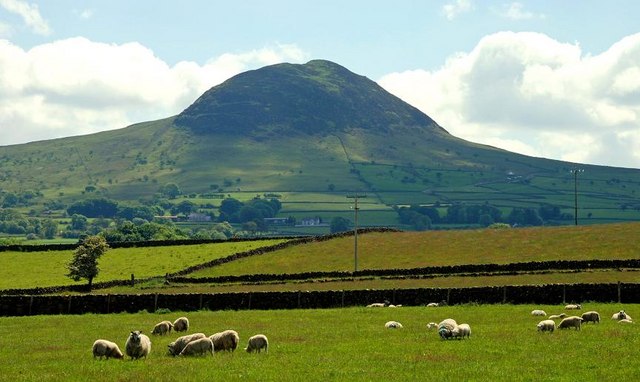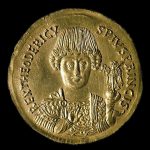St Patrick and Patricius decurialis: Catholic Saint and Enslaved Roman
- Erin Thomas Dailey
- 15 March 2024
- 0 Comment

Slemish, in present-day County Antrim, where some think Patricius laboured as a slave
Unlike most early medieval authors, who remain unknown to the broader public, St Patrick is a familiar figure. The details might not be wholly clear, but most people will confidently conjure ideas about him: ideas of emerald green, of shamrocks, and of a mythical expulsion of snakes from Ireland, the island over which he casts his saintly protection. But few will know that Patrick came to Ireland as a slave, and a foreigner, that he was born in Roman Britain to a family of rank, or that he bore a Latin name: Patricius. For the historian of late antique slavery, Patricius holds importance for other reasons, since (as emphasised recently by Judith Evans Grubbs) he is one of the very few people from the period both to have experienced slavery personally and to have written about the subject. Indeed, when he wrote of the ‘fears’ (terrores) and ‘threats’ (minae) faced by people captured and sold into slavery, he spoke with an authenticity and familiarity unparalleled in the sources.
Patricius was born perhaps around the year 400, when Britain remained a Roman province, in a villa of uncertain location (speculative sites have been suggested in Wales, Cumbria, the West Country, and even Northumbria). He described himself as freeborn (ingenuus), and his father as a decurion, a Roman title that carried prestige and honour, as well as local responsibilities that presumably lost force once the Empire withdrew its military and administrative presence from Britain while Patricus was still young. He also wrote that his father was a deacon, and his grandfather a priest, though he described his youth, prior to his capture at the hands of Irish raiders at the age of sixteen, as one of ‘ignorance’ and ‘unbelief’. His words evoke a sense of licence and luxury in a villa that, while perhaps unimpressive when compared to estates in neighbouring Gaul, nevertheless provided Patricius with the leisure and pleasures of a comfortable life enabled by the presence of domestic slaves (servi and ancillae, expressly mentioned by Patricius as belonging to his father and present in the household).
When raiders from Ireland arrived, Patricius found himself a captive alongside the slaves of the villa who had once served him. Sold into the possession of someone in Ireland, he spent six years as a shepherd, with ample time to reflect on his life. ‘Every day I grazed the sheep and prayed often,’ he wrote. ‘More and more my love of God grew. My fear of him and my faith in him increased until I offered one hundred prayers by day and nearly as many at night.’ Patricius eventually escaped and returned to his home in Britain ‘after a few years’ (which involved another enslavement that he chose not to detail). His family expected him to stay, but Patricius experienced a dream in which a man named Victoricus brought him ‘innumerable letters’ from the Irish requesting him to return: ‘We ask you, O holy slave, to come and walk among us again.’
Patricius discussed the successes and setbacks that he faced upon his return to Ireland. By his own account, he found many willing converts to accept Christian baptism, and even to dedicate themselves to an ascetic life and sexual abstinence. But this promotion of celibacy caused difficulty for Patricius because it disrupted the plans of parents to arrange advantageous marriages for their children. He spoke of the ‘persecution’ that young girls, in particular, faced from their families. Some of these converts were slaves, who ‘worked the most’ (maxime laborare), either in their daily toils, or in their pious deeds—the passage is terse and unclear. But he also made high profile converts: he mentioned one Irish noblewoman in particular, and he described how he travelled with Irish princes who offered him gifts (which he, of course, refused). Patricius also faced criticism from ecclesiastical leaders in Britain, where a functioning church remained despite the absence of Roman imperial support, for reasons unclear. These criticisms led him to produce a defence of his efforts, his Confession, which represents one of his two surviving works.
The other surviving text is his Letter to the Soldiers of Coroticus, in which he excoriated the men who served a reprehensible British warlord for attacking and enslaving his newly baptized followers. Patricius had attempted to secure their release, only for his emissaries to be rejected and even ridiculed for the request. He wrote to shame the recipients of his letter, who were fellow Christians, into releasing their coreligionist captives, rather than selling them to heathen masters:
The Christian Romans of Gaul are accustomed to dispatch holy men to the (barbarian and pagan) Franks, and to other heathen peoples, with thousands of gold coins to redeem baptised captives. You, however, slaughter them and sell them to pagan foreigners who are ignorant of God. You hand over the members of Christ, as it were, to a brothel. What hope do you have in God?
Patricius deployed the metaphor of the membra Christi to indicate that these captives were, as baptised people, part of the body of Christ, and thus anything inflicted upon them was also inflicted upon God. But his reference to the brothel (lupanar) was no mere metaphor. With this term, he referenced the vulnerability of these enslaved people to sexual exploitation as a part of their unfree condition. And he concluded his threat by proclaiming, in a reference to scripture (Romans 1:32), that ‘not only the evildoers, but also those who conspire with them, are to be condemned’. The implications were clear: those who sold baptised Christians into slavery were guilty of the sexual violation of the body of Christ. Such strong words issued from someone who had experienced slavery himself.
Patricius might have thought that his own enslavement served a higher purpose, as it allowed him to reflect upon God and to increase his prayers and devotion, but he also knew what slaves might experience at the hands of their owners. Does this represent a changed outlook for the man who had grown up with domestic slaves in his family villa prior to his own capture, and who later returned there, only to depart for Ireland to spread Christian practice in a foreign land? It is certainly tempting to think so. Patricius’s outrage, however, was directed specifically toward the enslavement of baptised people (and perhaps also freeborn people) to pagan masters. If his outrage stayed within these limits, then he was like many of his contemporaries who opposed what they considered to be wrongful enslavement, while supporting slaveholding practices more generally, and even while owning slaves themselves. But if his outrage exceeded these particular limits—and perhaps it did—then Patricius is an even more intriguing figure for the historian of late antique slavery. And, of course, he is also an even more intriguing figure for the wider public, who mark St Patrick’s Day with celebrations on 17 March.




